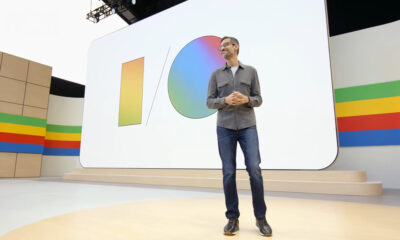News
Introducing Bard, Google’s Response To ChatGPT
The search giant’s new chatbot is still being tested, but is set to launch in the coming weeks with an API available for developers to build into their own creations.

As the hype builds around startup OpenAI’s chatbot, ChatGPT, Google is keen to stay ahead of the Microsoft-funded competition. To that end, the search giant will roll out its own version of the technology named Bard over the coming weeks.
Sundar Pichai, Google’s CEO, has announced that Bard is already available to “trusted testers” and is designed to harness the “breadth of the world’s knowledge” behind a conversational-looking interface. Pichai did not announce concrete plans to integrate Bard into the company’s main search box, instead pointing to a novel and more cautious use of the technology to enhance conventional searches.
The news of Google’s foray into chatbot-style AI comes after Microsoft’s recent investment of $10 billion into ChatGPT’s parent company, OpenAI. ChatGPT has grown into an internet sensation over the last few months, however, some experts advise caution after noticing that the bot is prone to making up answers or copying its responses from other online sources.
Also Read: Best Music Streaming Services In The Middle East
Interestingly, the ChatGPT engine is built on top of an AI model known as Transformer, which Google itself first invented. After Google researchers listed severe limitations in the concept in a 2020 paper, two prominent ethical AI researchers, Timnit Gebru and Margaret Mitchell, were fired from the search giant, while others are said to remain frustrated at Google’s hesitancy to harness the technology thoroughly.
So what differences can we expect from Google’s new Bard software when it releases? In Sundar Pichai’s blog post on Monday, the CEO offered the example of asking Bard “to explain discoveries made by NASA’s James Webb Space Telescope in a way that a 9-year-old might find interesting”. Bard responds in a conversational bullet-point style, with the first one reading, “In 2023, The JWST spotted several galaxies nicknamed green peas. They were given this name because they are small, round, and green, like peas”.
News
Mamo Completes $3.4M Funding Round To Enhance Fintech Services
The startup will use the influx of cash to expand into Saudi Arabia and across the wider GCC while improving its product offering.

UAE-based fintech Mamo has announced the completion of a $3.4 million funding round that will help the startup extend its market presence and improve its product offering. Investors included 4DX Ventures, the Dubai Future District Fund and Cyfr Capital.
Mamo’s platform offers “payment collection, corporate cards and expense management” to help small and medium-sized businesses consolidate and streamline their operations. With the latest influx of capital, Mamo will further develop its comprehensive suite of services and begin testing its product lines in Saudi Arabia, further extending its footprint across the GCC.
Imad Gharazeddine, co-founder and CEO of Mamo, stated: “We’ve been in the market for a while now and are incredibly proud of what our team has achieved. The holistic and expansive nature of our product offering has helped us continue to grow sustainably. This additional funding will allow us to reach our medium-term goals even faster. The support from new and existing investors is a testament to our strong expertise and the ability to deliver on our customer promise”.
Daniel Marlo, General Partner of lead investor 4DX Ventures, added: “We have immense trust in Imad’s vision, leadership and Mamo’s innovative approach to provide a user-friendly and comprehensive financial solution for SMEs that makes financial management more accessible and efficient. We are proud to partner with them and support their mission”.
Also Read: A Guide To Digital Payment Methods In The Middle East
Amer Fatayer, Managing Director of Dubai Future District Fund’s investment team, also commented: “Mamo’s localized product lines serve as an infrastructure for SME payments and spend management in UAE, a segment that is underserved by the country’s current banking infrastructure. The team has taken a product-first approach to consolidating SMEs’ financial journeys and building a fintech solution deeply embedded in a business’s core operations”.
To date, Mamo has raised around $13 million in investment funding and now boasts a team of 30 people. The company’s intuitive financial services platform has allowed over 1,000 businesses to consolidate their financial operations and significantly reduce payment fees.
-

 News4 weeks ago
News4 weeks agoAmazon Prime Day 2024: Get Ready For 6 Days Of Amazing Deals
-

 News4 weeks ago
News4 weeks agoSamsung Unpacked 2024: What To Expect From The July 10 Event
-

 News4 weeks ago
News4 weeks agoCoursera Report Shows Surge In UAE Interest In AI Upskilling
-

 News4 weeks ago
News4 weeks agoMeet Dubai’s Groundbreaking Smart Robot Delivery Assistant















